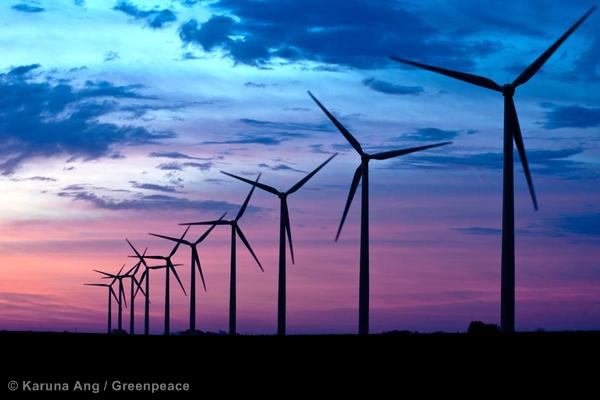Amazon.com announced yesterday that it would purchase the electricity from a new 208 MW wind farm in Eastern North Carolina, the largest wind farm in the entire Southeastern U.S.
The deal confirms two things: First, that Amazon is serious about its goal to power its Amazon Web Services division with 100% renewable energy, and second, that utilities and state governments better get equally serious about providing renewable energy if they intend to win more business from the biggest companies of the internet economy.
Amazon deserves praise for helping to catalyze the first large-scale wind farm in the Southeast, and Amazon Web Services customers should feel good knowing that AWS is listening to their requests for more renewable energy.
It’s also encouraging that Amazon explicitly expressed that it would continue to push utilities for more renewable energy and that it would support renewable energy tax incentives from governments, as its advocacy for strong renewable energy policies will be a key component of how it reaches 100% renewable energy in the long run. From Amazon’s press release:
“We’re far from being done. We’ll continue pursuing projects that deliver clean energy to the various energy grids that serve AWS data centers, we’ll continue working with our power providers to increase their renewable energy quotient, and we’ll continue to strongly encourage our partners in government to extend the tax incentives that make it more viable for renewable projects to get off the ground.”
That statement should provoke serious questions of government and utility leaders in the Southeast. For North Carolina Gov. Pat McCrory, who praised the new wind farm at a press conference this morning: Will he support extending North Carolina’s solar tax credits so that North Carolina can stay competitive at drawing large tech companies like Amazon, Apple, Facebook and Google to the state?
For Dominion, Amazon’s main utility provider in Virginia: will they start providing more renewable energy to its customers that clearly are demanding it, and in this case, going elsewhere to purchase it since Dominion isn’t responsive to those needs?
For Virginia’s legislators: will they start enacting renewable energy friendly policies to keep hundreds of millions of dollars worth of investment from internet leaders like Amazon at home, instead of going across state borders to North Carolina?
Amazon’s investment, plus its commitment to do more and to keep pushing utilities and state officials, all puts it on the right path to becoming a green internet leader, but there is a catch: While Amazon is now competing with Apple, Facebook and Google in the race to build a 100% renewably powered internet, it still lags far behind those companies for its lack of transparency about its energy use with customers and the public. Given the progress that AWS has made with its new wind and solar farms, it’s a wonder that Amazon still has yet to publish data to its customers or the public about its energy footprint.
Without publishing information about its energy usage, crucial questions remain unanswered about this deal, including:
- How much of Amazon’s electricity use will actually be covered by this new wind farm? Amazon still has yet to disclose the energy use of its data center regions or its total footprint, unlike many of its peers. Until Amazon’s does so, customers will be unable to gauge just how much of a dent the wind or solar farms are making in its energy and carbon footprints.
- How much coal, gas and nuclear power is Amazon still consuming to power its data centers in Virginia? More information is needed especially because Dominion is pursuing expansions of gas and nuclear power plants, justified by the growth of data centers like Amazon’s.
Amazon can put those questions to rest by publishing information about its energy footprint, as its peers have done. Overall though, this is good news worth celebrating. Amazon, the company responsible for the fastest growing infrastructure underpinning our internet, is accelerating its pace toward 100% renewable energy, and now large-scale wind energy will finally come to a part of the country in desperate need of it because of that fact.
Greenpeace will update our scores of Amazon from our most recent Clicking Clean report later this year, and provide further analysis of how Amazon can embrace greater transparency and move faster toward its goal of 100% renewable energy.



